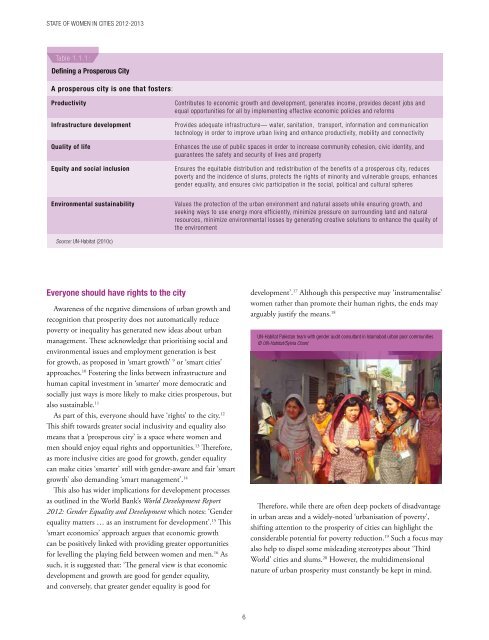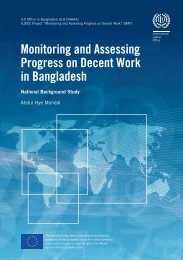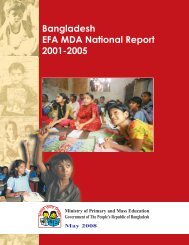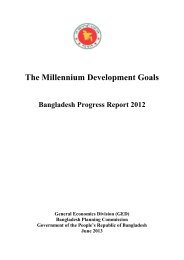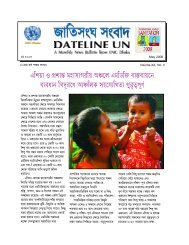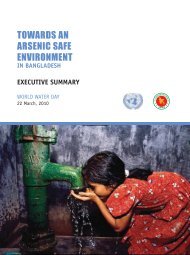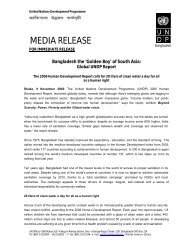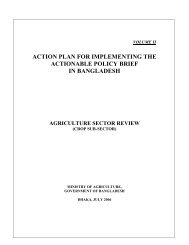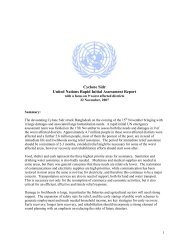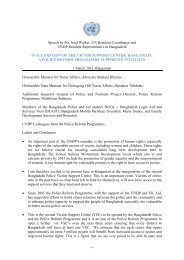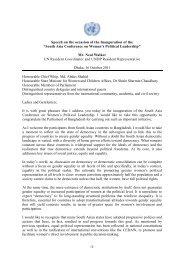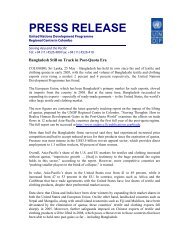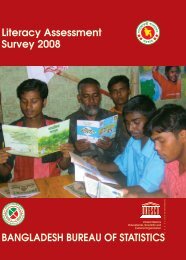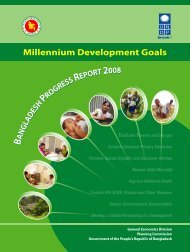STATE OF WOMEN IN CITIES 2012-2013 - UN-Habitat
STATE OF WOMEN IN CITIES 2012-2013 - UN-Habitat
STATE OF WOMEN IN CITIES 2012-2013 - UN-Habitat
You also want an ePaper? Increase the reach of your titles
YUMPU automatically turns print PDFs into web optimized ePapers that Google loves.
<strong>STATE</strong> <strong>OF</strong> <strong>WOMEN</strong> <strong>IN</strong> <strong>CITIES</strong> <strong>2012</strong>-<strong>2013</strong><br />
Table 1.1.1:<br />
Defining a Prosperous City<br />
A prosperous city is one that fosters:<br />
Productivity<br />
Infrastructure development<br />
Quality of life<br />
Equity and social inclusion<br />
Environmental sustainability<br />
Contributes to economic growth and development, generates income, provides decent jobs and<br />
equal opportunities for all by implementing effective economic policies and reforms<br />
Provides adequate infrastructure— water, sanitation, transport, information and communication<br />
technology in order to improve urban living and enhance productivity, mobility and connectivity<br />
Enhances the use of public spaces in order to increase community cohesion, civic identity, and<br />
guarantees the safety and security of lives and property<br />
Ensures the equitable distribution and redistribution of the benefits of a prosperous city, reduces<br />
poverty and the incidence of slums, protects the rights of minority and vulnerable groups, enhances<br />
gender equality, and ensures civic participation in the social, political and cultural spheres<br />
Values the protection of the urban environment and natural assets while ensuring growth, and<br />
seeking ways to use energy more efficiently, minimize pressure on surrounding land and natural<br />
resources, minimize environmental losses by generating creative solutions to enhance the quality of<br />
the environment<br />
Source: <strong>UN</strong>-<strong>Habitat</strong> (2010c)<br />
Everyone should have rights to the city<br />
Awareness of the negative dimensions of urban growth and<br />
recognition that prosperity does not automatically reduce<br />
poverty or inequality has generated new ideas about urban<br />
management. These acknowledge that prioritising social and<br />
environmental issues and employment generation is best<br />
for growth, as proposed in ‘smart growth’ 9 or ‘smart cities’<br />
approaches. 10 Fostering the links between infrastructure and<br />
human capital investment in ‘smarter’ more democratic and<br />
socially just ways is more likely to make cities prosperous, but<br />
also sustainable. 11<br />
As part of this, everyone should have ‘rights’ to the city. 12<br />
This shift towards greater social inclusivity and equality also<br />
means that a ‘prosperous city’ is a space where women and<br />
men should enjoy equal rights and opportunities. 13 Therefore,<br />
as more inclusive cities are good for growth, gender equality<br />
can make cities ‘smarter’ still with gender-aware and fair ‘smart<br />
growth’ also demanding ‘smart management’. 14<br />
This also has wider implications for development processes<br />
as outlined in the World Bank’s World Development Report<br />
<strong>2012</strong>: Gender Equality and Development which notes: ‘Gender<br />
equality matters … as an instrument for development’. 15 This<br />
‘smart economics’ approach argues that economic growth<br />
can be positively linked with providing greater opportunities<br />
for levelling the playing field between women and men. 16 As<br />
such, it is suggested that: ‘The general view is that economic<br />
development and growth are good for gender equality,<br />
and conversely, that greater gender equality is good for<br />
development’. 17 Although this perspective may ‘instrumentalise’<br />
women rather than promote their human rights, the ends may<br />
arguably justify the means. 18<br />
<strong>UN</strong>-<strong>Habitat</strong> Pakistan team with gender audit consultant in Islamabad urban poor communities<br />
© <strong>UN</strong>-<strong>Habitat</strong>/Sylvia Chant<br />
Therefore, while there are often deep pockets of disadvantage<br />
in urban areas and a widely-noted ‘urbanisation of poverty’,<br />
shifting attention to the prosperity of cities can highlight the<br />
considerable potential for poverty reduction. 19 Such a focus may<br />
also help to dispel some misleading stereotypes about ‘Third<br />
World’ cities and slums. 20 However, the multidimensional<br />
nature of urban prosperity must constantly be kept in mind.<br />
6


